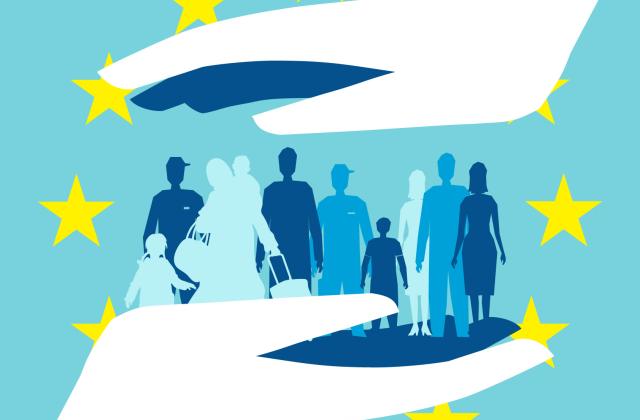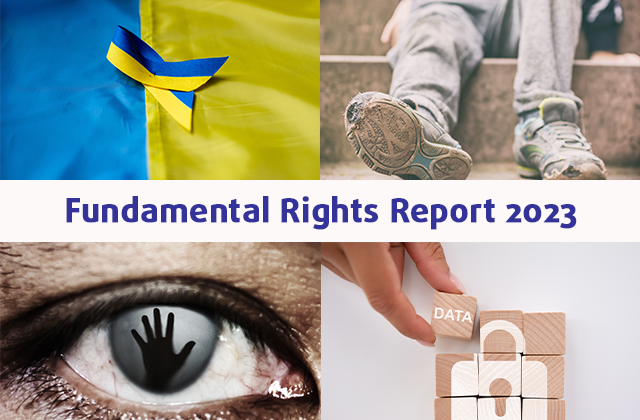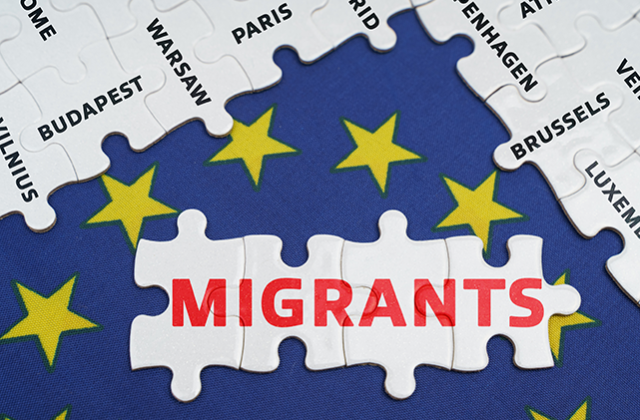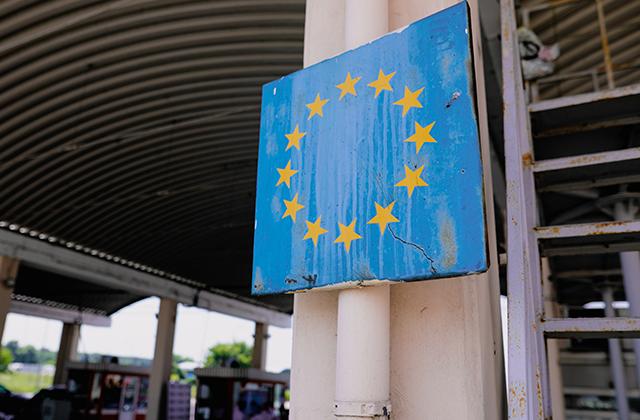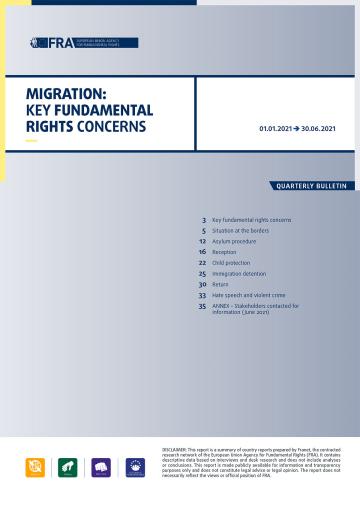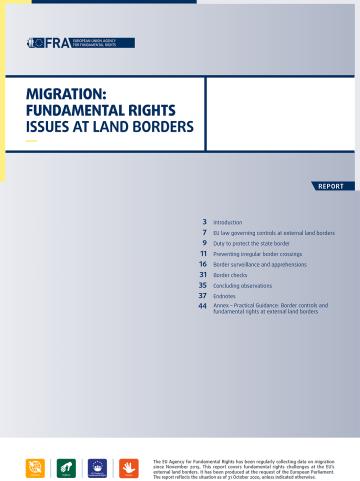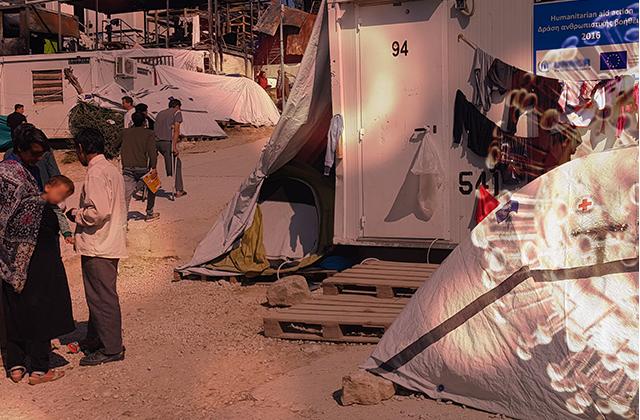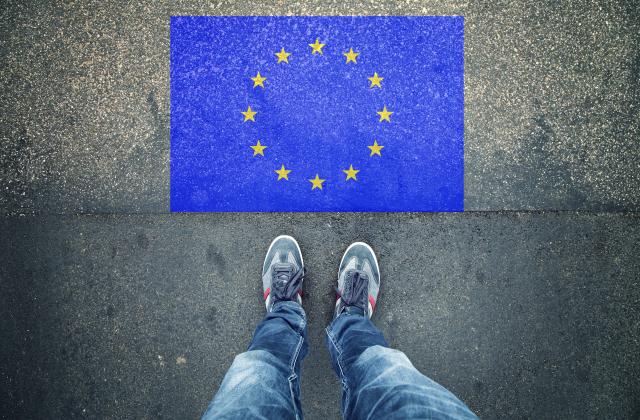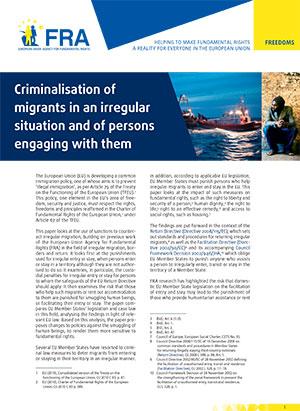- The events at the Greek–Turkish land border in March 2020 when Türkiye announced it would no longer prevent migrants from crossing into the EU, at the EU border with Belarus in the summer of 2021 and at the Finnish border in the end of 2023 triggered policy measures which may have long-lasting consequences for the protection of fundamental rights at the EU’s external borders. The annex presents relevant developments, listing also the events in May 2021, when some 8 000 migrants attempted to enter the Spanish town of Ceuta from Morocco.
-
The developments at the Belarus border best illustrate the fundamental rights challenges resulting from the way in which the authorities react to this phenomenon, generally referred to as the ‘instrumentalisation of migrants’ (see paragraph 24). There, on a daily basis, people cross the EU’s external border and are redirected back, partly by force, to Belarus, a country which the European Court of Human Rights (ECtHR) considered not to be safe [1]
See, for example, judgment of the Fourth Section of the ECtHR of 11 December 2018, M.A. and Others v Lithuania, No 59793/17, paragraph 115; judgment of the First Section of the ECtHR of 23 July 2020, M.K. and Others v Poland, Nos 40503/17, 42902/17 and 43643/17, paragraphs 183–186; judgment of the First Section of the ECtHR of 8 July 2021, D.A. and Others v Poland, No 51246/17, paragraphs 69–70; judgment of the First Section of the ECtHR of 30 June 2022, A.B. and Others v Poland, No 42907/17, paragraphs 38–43; and judgment of the First Section of the ECtHR of 30 June 2022, A.I. and Others v Poland, No 39028/17, paragraphs 40–46.
. The Grand Chamber of the ECtHR will rule on three cases concerning alleged unlawful summary returns from Latvia, Lithuania and Poland to Belarus, concerning alleged breaches of Articles 2, 3 and 13 of the European Convention on Human Rights (ECHR) and Article 4 of Protocol No 4 to the ECHR [2]
Relinquishment in favour of the Grand Chamber of the ECtHR of 25 June 2024, R.A. and Others v Poland, No 42120/21; relinquishment in favour of the Grand Chamber of the ECtHR of 2 July 2024, H.M.M. and Others v Latvia, No 42165/21; and relinquishment in favour of the Grand Chamber of the ECtHR of 16 April 2024, C.O.C.G. and Others v Lithuania, No 17764/22.
. Events in Greece and Morocco were of short duration and in Finland, only a limited number of people arrived after the country closed its land border. - The number of people who reached the EU as a result of this phenomenon may appear low if compared to irregular arrivals across the Mediterranean Sea. At the same time, the approximately 8 000 border crossings from Belarus to the three bordering Member States in 2021 represented a significant increase compared to the years before. In Finland, arrivals at border crossing points in late 2023 rose from single digits to hundreds per week.
-
Using migrants as part of hostile activities is not new. Academic literature describes multiple situations in which governments and non-state actors use or threaten to use population movements for their political or military objectives [3]
See, for example, Greenhill, K. M., Weapons of Mass Migration: Forced displacement, coercion, and foreign policy, Cornell University Press, 2010; and Greenhill, K. M., ‘Migration as a weapon in theory and in practice’, Military Review, November–December 2016; and The European Centre of Excellence for Countering Hybrid Threats, Fakhry, A., Rácz, A. and Parkes, R., ‘Migration instrumentalization: A taxonomy for an efficient response’, Hybrid CoE Working Papers, No 14, March 2022.
. -
The role that third countries have played in facilitating or orchestrating irregular migration to the EU’s external borders led to various actions to counter such instrumentalisation. The phenomenon is treated as a ‘hybrid threat’ [4]
See, for example, Eighth progress report on the implementation of the 2016 joint framework on countering hybrid threats and the 2018 joint communication on increasing resilience and bolstering capabilities to address hybrid threats, SWD(2024) 233 final of 10 October 2024, p. 10; and Bachmann, S. D. and Paphiti, A., ‘Mass migration as a hybrid threat? A legal perspective’, Polish Political Science Yearbook, Vol. 50, No 1, 2021, pp. 119–145.
. Hybrid threats describe hostile acts which remain below the threshold of formal warfare [5]
For an EU description of hybrid threats, see European Commission, ‘Hybrid threats’, European Commission – Defence Industry and Space website.
. Examples of hybrid threats include cyberattacks, massive disinformation campaigns to control the political narrative in the EU and measures disrupting the functioning of critical infrastructure, such as energy supply chains, transport or satellite communication [6]
See also Joint communication to the European Parliament and the Council – Joint framework on countering hybrid threats – A European Union response, JOIN(2016) 18 final of 6 April 2016.
. -
This defence dimension risks overshadowing the human reality and the vulnerability of those being instrumentalised, many of whom are people in need of international protection. In Greece, in March 2020, some allegations – though denied by the authorities – referred to the use of live ammunition that reportedly resulted in the death of two persons and caused several injuries. In light of violent incidents at the border [7]
For examples of incidents, see the introductory paragraph in Mikolajczyk B., ‘Polish law restricting the right to asylum at borders’, in EU Immigration and Asylum law and Policy, 3 July 2025 and the press article by Notes from Poland (NFP), ‘Poland shows “uniformed Belarusian officer” among migrant group attacking Polish border guards’, 14 April 2025.
, Poland’s Homeland Defence Act of July 2024 broadens soldiers’ and police officers’ rights to use firearms at the border, a measure which also heightens the risks to the right to life as protected by Article 2 of both the Charter and the ECHR [8]
Poland, Ustawa z dnia 29 lipca 2024 r. o zmianie ustawy – Ustawa o obronie Ojczyzny oraz niektórych innych ustaw [Act of 29 July 2024 amending the Act on the Defence of the Homeland and certain other acts], Dz.U. 2024 poz. 1377.
. In 2023 and 2024, almost 60 people died along the EU land border with Belarus, many from hyperthermia while stranded in the border area [9] International Organization for Migration, information provided to FRA in June 2025.
. About half of the people trapped in the forest on the Polish–Belarusian border MSF treated between November 2022 and November 2024 reported physical injuries related to violence. While violence was reported on both sides of the border, most patients reported experiencing abuse in Belarus [10]
MSF, ‘Uwięzieni pomiędzy granicami. Zagrażające życiu konsekwencje zwiększonej militaryzacji i przemocy na granicy polsko-białoruskiej’, MSF website, 4 February 2025.
. - The term ‘weaponisation’ of migration has emerged in EU documents. It focuses on geopolitical considerations and overshadows the humanitarian and human rights aspects of what happens at borders. In December 2024, the European Commission issued a communication on countering hybrid threats from the weaponisation of migration recognising that ‘Member States may adopt exceptional measures to defend themselves against external threats’. The EU’s internal security strategy of April 2025 announces further work to counter the ‘weaponisation of migration’.
- In its conclusions in October 2021, the European Council underlined that it ‘will not accept any attempt by third countries to instrumentalise migrants for political purposes’ and condemned all hybrid attacks at the EU’s borders. In the conclusions of October 2024, it emphasised that a third country cannot be allowed to abuse EU values, including the right to asylum, and reaffirmed its commitment to countering the instrumentalisation of migrants for political purposes.
- EU law defines ‘instrumentalisation of migrants’ in Article 1(4)(b) of Regulation (EU) 2024/1359 (Crisis and Force Majeure Regulation) addressing situations of crisis and force majeure in the field of migration and asylum. This definition consists of the following four elements.
- Actor: a third country or a hostile non-state actor.
- Action: encouraging or facilitating the movement of third-country nationals to the EU’s external border or to a Member State.
- Intention: the action is carried out with the aim of destabilising the EU or a Member State.
- Intensity: the action may objectively put at risk essential Member State functions, including the maintenance of law and order or protection of its national security.
- Article 5(4) of the Schengen Borders Code, as amended by Regulation (EU) 2024/1717, uses this definition when regulating the measures that Member States can take at their external borders.
- Recitals 15 and 16 of the Crisis and Force Majeure Regulation clarify that migrant smuggling and the provision of humanitarian assistance should not be considered as instrumentalisation ‘when there is no aim to destabilise’ the EU or a Member State. Recital 12 of Regulation (EU) 2024/1717 echoes the same distinctions.
- Article 1(4)(b) of the Crisis and Force Majeure Regulation does not require that migrants or refugees arrive in large numbers for a situation of instrumentalisation to exist. The key factor is whether the action is ‘liable to put at risk essential functions of a Member State’. In principle, this is a high threshold, likely to be met only in very exceptional situations.
-
At the same time, evidence to underpin instrumentalisation will often be classified and, therefore, not subject to public scrutiny. Academic literature points to difficulties stemming from the definition of instrumentalisation under EU law. For instance, establishing whether the hostile aim of the undertaken actions is political destabilisation will be crucial to differentiate instrumentalisation from migrant smuggling, which can be very difficult at times [11]
See, for example,Goldner Lang, I., ‘Instrumentalisation of migrants: It is necessary to act, but how?’, EU Immigration and Asylum Law and Policy – Blog of the Odysseus Academic Network website, 15 October 2024; European Parliamentary Research Service, Carrera, S., Colombi, D., Campesi, G., Gori, M. et al., Proposal for a regulation addressing situations of instrumentalisation in the field of migration and asylum – Substitute impact assessment, European Union, Brussels, 2023, pp. 10–12; European Council on Refugees and Exiles (2024), ECRE Comments on the Regulation of the European Parliament and of the Council on Addressing Situations of Crisis and Force Majeure in the Field of Asylum and Migration amending Regulation (EU) 2021/1147, Brussels, May 2024, pp. 9-13; andForti, M.,‘Belarus-sponsored migration movements and the response by Lithuania, Latvia and Poland: A critical appraisal’, European Papers, Vol. 8, No 1, 11 July 2023, pp. 229–230.
. - To counter the risk of an overly broad interpretation of this formulation, the Crisis and Force Majeure Regulation establishes procedural requirements. First, Member States must describe how essential functions of the state are put at risk (Article 2). Second, the Commission must assess whether the situation can be addressed sufficiently through other means (Article 3(4)d)) and, if not, describe why this is not the case (Article 3(7)). It also sets upper time limits for any derogation (Article 5). Restricting fundamental rights for longer than what is strictly necessary to address the situation would not be compatible with the Charter.
-
The instrumentalisation of migrants and refugees must be distinguished from spontaneous unauthorised arrivals, including large numbers of people, whether facilitated by smugglers or not. After the increased arrivals to the EU in 2015 and 2016, some Member States enacted or proposed emergency measures to counter irregular immigration, invoking national security concerns. For example, since September 2015, Hungary has been maintaining a ‘state of crisis due to mass migration’ [12]
National Legislation of Hungary, 30/2025. (III. 5.) Korm. rendelet a tömeges bevándorlás okozta válsághelyzet Magyarország egész területére történő elrendeléséről, valamint a válsághelyzet elrendelésével, fennállásával és megszüntetésével összefüggő szabályokról szóló 41/2016. (III. 9.) Korm. rendelet módosításáról [Government Decree No 30/2025 (III.5.) amending Government Decree No 41/2016 (III.9.) on declaring astate of crisis caused by mass immigration for the entire territory of Hungary and on the rules related to the ordering, existence and termination of the state of crisis], Article 1.
and implementing asylum and return policies, which the Court of Justice of the European Union (CJEU) found to be in violation of EU law [13]
See judgment of the Court of Justice of 17 December 2020, Commission v Hungary, C-808/18, ECLI:EU:C:2020:1029; judgment of the Court of Justice of 22 June 2023, Commission v Hungary, C-823/21, ECLI:EU:C:2020:1029; and judgment of the Court of Justice of 13 June 2024, Commission v Hungary, C-123/22, ECLI:EU:C:2024:493 (CJEU ordering record amount of lump sum and periodic penalty payment due to non-compliance with its ruling in case C-808/18).
. Such measures are unrelated to instrumentalisation and not covered in this position paper. - This FRA position paper uses the wording ‘instrumentalisation of migrants and refugees’, except when referring to EU law definitions, as this phenomenon affects people seeking international protection. Under EU law and international human rights and refugee law binding on Member States, refugees and other people in need of international protection are entitled to specific protection measures. Such protection obligations are reflected, where relevant, in the ensuing legal analysis.
- Actions that the EU and its Member States take to counter the instrumentalisation of migrants and refugees that fall within the scope of EU law must respect EU fundamental rights law, including the Charter, which under Article 6(1) of the Treaty on European Union (TEU) has the same legal value as the EU Treaties.
-
Even when Member States act outside the scope of EU law, Member States must respect the safeguards deriving from national constitutional law and international law, in particular the ECHR, as the CJEU underlined in relation to dignified treatment during border checks [14]
See judgment of the Court of Justice of 17 January 2013, Mohamad Zakaria, Case C‑23/12, ECLI:EU:C:2013:24, paragraph 41.
. - Legal and operational responses to the instrumentalisation of migrants and refugees in some Member States restrict fundamental rights to such a degree that it creates serious tensions with primary EU law and international law. This position paper focuses on EU fundamental rights law.
- To prevent migrants and asylum applicants from entering the EU by circumventing border controls, Member States are resorting to the use of force, including when dealing with children and other people with vulnerabilities. Under the Charter, the use of force which is not necessary and proportionate interferes with the right to the integrity of the person (Article 3), may result in people’s death, violating the right to life (Article 2) and may amount to torture, inhuman or degrading treatment, which is prohibited by Article 4 of the Charter. It may also conflict with the provisions in Articles 24 to 26 of the Charter that protect children, the elderly and persons with disabilities.
- Informal returns or redirections of third-country nationals to the EU external border threaten the long-standing customary international law rule prohibiting refoulement, which bans states from returning individuals to persecution or other serious harm. The Charter prohibits refoulement in Article 19(2) (protection in the event of removal, expulsion or extradition) and implicitly in Article 4 (prohibition of torture and other forms of ill-treatment) and in Article 18 (right to asylum).
-
A recurrent measure Member States have taken to counter the instrumentalisation of migrants and refugees is to restrict access to asylum. Access to international protection procedures is a key aspect of the right to asylum in Article 18 of the Charter and an essential element of the common European asylum system [15]
See Regulation (EU) 2024/1348 (Asylum Procedure Regulation), Articles 4(1) and 4(2); Regulation (EU) 2024/1347 (Qualification Regulation), Article 7(2); Regulation (EU) 2024/1356, Article 3; and Regulation (EU) 2024/1351, Article 4(1)(d).
. - Certain fundamental rights may be limited, respecting the requirements set out in Article 52(1) of the Charter. Under Article 52(1) of the Charter, limitations to Charter rights must be provided for by law, be necessary and proportionate and respect the essence of the rights. Any response to an exceptional situation, such as instrumentalisation, must be limited in time. Other rights are absolute and cannot be restricted or derogated from. These include, in particular, the prohibition of torture and other forms of ill-treatment and the principle of non-refoulement.
- This FRA legal analysis presents a set of tools that the EU and its Member States have at their disposal to respond to instances of instrumentalisation of migrants and refugees. Several of these tools are rights-compliant, provided they are accompanied by certain safeguards. The analysis also includes the EU law instruments adopted with the pact on migration and asylum, which will apply as of mid-2026.
- The EU and its Member States can use a variety of tools to counter instrumentalisation. Such a toolbox includes:
- measures against the actor who instrumentalises migrants (Chapter 1);
- measures against the private operators that support the actor (Chapter 2);
- measures to deal with arriving migrants and refugees (Chapter 3); and
- measures linked to the involvement of the military at borders (Chapter 4).
- In light of Recital 4 of Regulation (EU) 2022/555, amending its founding Regulation (EC) No 168/2007, FRA is not in a position to provide advice on acts or activities in relation to or in the framework of the EU’s common foreign and security policy (CFSP). This position paper refers, to a certain extent, to measures covering these areas to enable the reader to have an overview. The agency’s advice itself concerns matters falling under its mandate, primarily Articles 77 to 79 of the Treaty on the Functioning of the European Union (TFEU).





